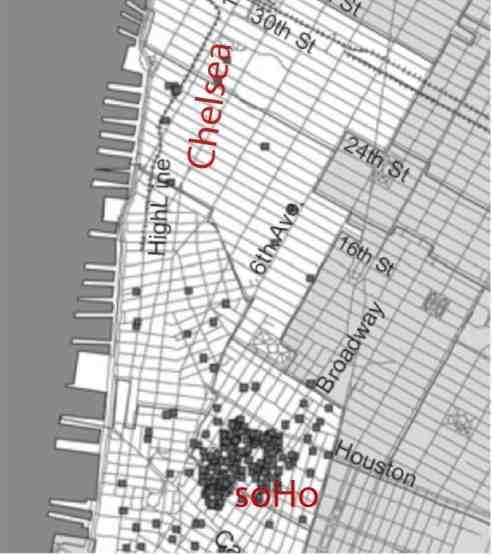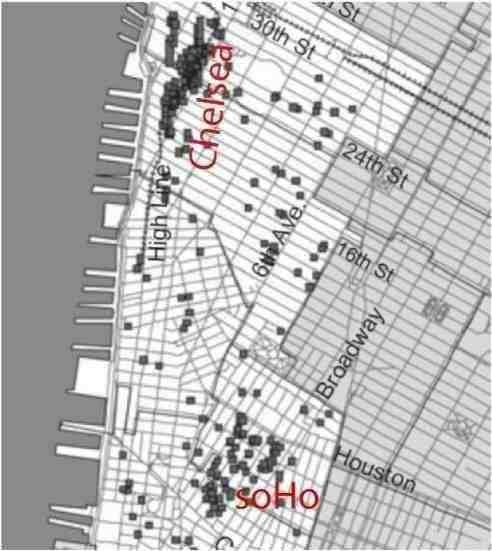To understand the move from soho to Chelsea at such rapid speed, it is best to understand the topography and history of these two places. By 1900, the Chelsea neighborhood was solidly Irish and housed the longshoremen who unloaded freighters at warehouse piers that lined the nearby waterfront and the truck terminals integrated with the freight railroad spur.
Chelsea was an early center for the motion picture industry before World War I. Some of Mary Pickford's first pictures were made on the top floors of an armory building on West 26th St. there was also the Elliot Chelsea house that contained an off-Broadway theater and fine arts programs. As New York's visual arts community moved from Soho to West Chelsea in the 1990s, the area has become one of the global centers of modern contemporary art. The West Chelsea Arts District is home to over 370 art galleries and innumerable artist studios. The area has also become home to the modern dance companies and well regarded performance venues and theaters. Since the mid-1990s, Chelsea has become a center of the New York art world, as art galleries moved there from Soho. there are more than 350 art galleries that are home to modern art from upcoming artists and respected artists as well.
Soho,After the city abandoned LoMEx, was still left with a large number of historic buildings that were unattractive for the kinds of manufacturing and commerce that survived in the city in the 1970s. Many of these buildings, especially the upper stories which became known as lofts, attracted artists who valued the spaces for their large areas, large windows admitting natural light and dirt-cheap rents. Most of these spaces were also used illegally as living space, being neither zoned nor equipped for residential use, but this was ignored for a long period because the occupants were using space that would probably have been dormant or abandoned in the poor economic conditions of the era. At the beginning of the 20th century, the Soho neighborhood had changed once again, earning a reputation as a manufacturing and commercial zone during the industrial revolution. The New York City’s population was exploding from immigration, and Soho was no longer a suburb of downtown Manhattan. Retail stores had gone further north. Large loft apartments gave artists the space they sought for their work, and served as a creative forum for carving out residential housing in what were once factories and commercial lofts.
Galleries in SoHo and Chelsea in 1995
From the history of these two places, my conclusion is that, the primary reason for this entire shift is monetary issues in relation to price of buildings. Soho, was once the driving city of art galleries because the buildings were huge, and cheap, and it was the delight for all artist, gallery owners and museums. When soho started to become a more industrialized and commercialized district, naturally the cost of living became high, and for galleries and artist who I believe were not making much then, they had to move and what better place to move to than Chelsea, a place which also had a historic artistic culture. I believe that the move was not only because it was an artistic center, but it was also cheap, and there was space to occupy all these galleries that moved there. Now the fact that there was an immense migration does not mean that soho is no more artistically inclined. There are still galleries all over the place in soho.
Galleries in soHo and Chelsea in 2007
To think that Chelsea will eventually end up like soho, is impossible. I say this because of many reasons. First, space is very important, and NY city lacks space in a neighborhood to have a new move of migration. Secondly, galleries and artist, at least for the ones that are represented in galleries and museums have money. The art world is making enough money to be able to pay for rent should they get any higher, because the hunger for acquiring art is high, money has become the main goal for these people and they are making it. Also in this current globalized world, there is no doubt that, other companies will move in quickly to a newly emerging community which makes money, that will turn it into an industrial and commercial neighborhood in a few years.
I think that Chelsea has grown to have a strong foundation and established stronghold as the art center of the contemporary world and it has come to stay. There might be extensions of this, but the headquarters will be Chelsea.

